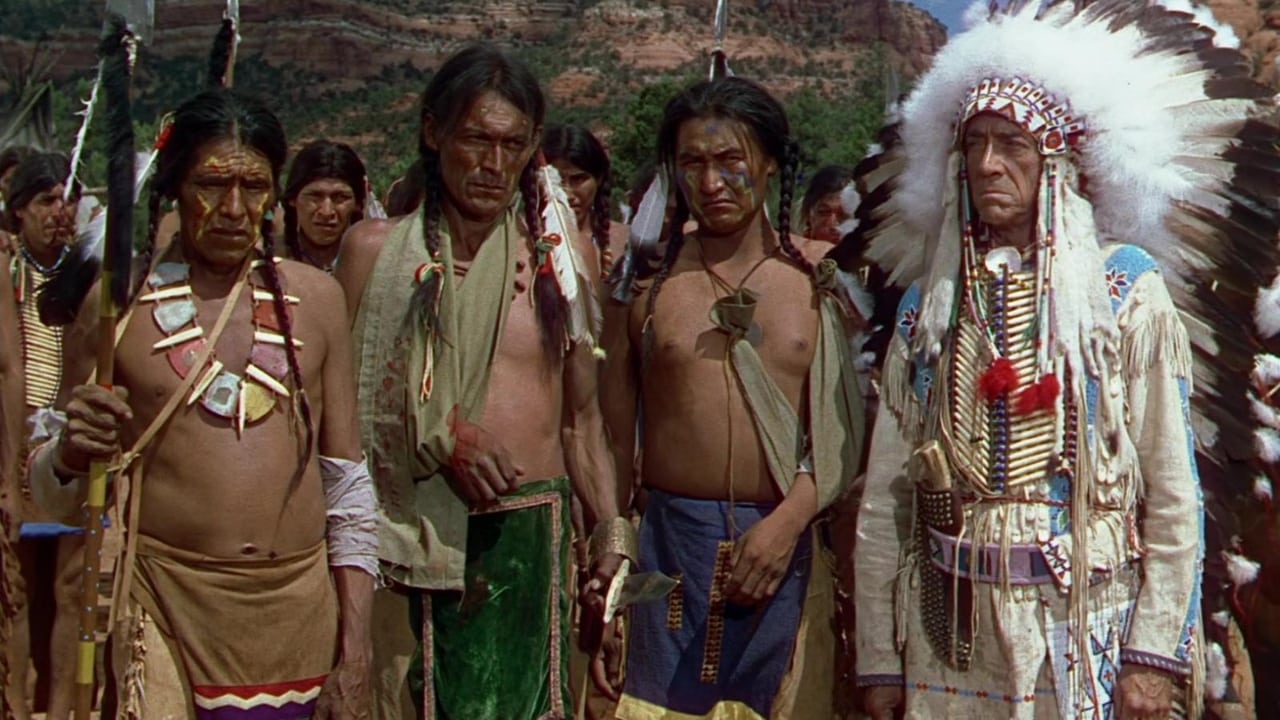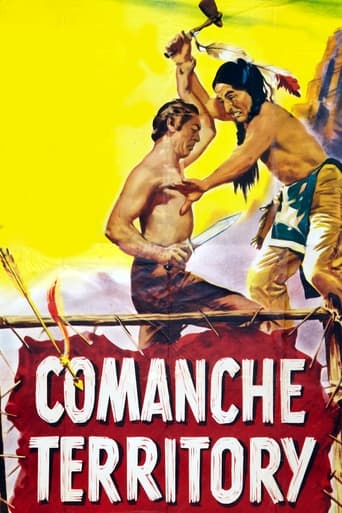

What a beautiful movie!
... View MoreToo many fans seem to be blown away
... View Moreone of my absolute favorites!
... View MoreIf you're interested in the topic at hand, you should just watch it and judge yourself because the reviews have gone very biased by people that didn't even watch it and just hate (or love) the creator. I liked it, it was well written, narrated, and directed and it was about a topic that interests me.
... View MoreBefore Maureen O'Hara got spanked on film by John Wayne for her shrewish behavior, she got kicked in the behind several times by Macdonald Carey(as newcomer Jim Bowie), while pinned under a table in a saloon fight. This was in retaliation for her general hostile attitude toward him and her refusal to cash his bank draft as president of the bank or as owner of the saloon in the frontier town of Crooked Tongue in Comanche territory, presumably somewhere in Texas in the 1830s. Probably, the town name had the same meaning to the Comanche as 'forked tongue': their impression of most Europeans. Well, Maureen, as character Katie Howard, had a right to be angry with this stranger, 'cause he busted up her show of riding from one end of town to the other without spilling 2 mugs of beer on a tray she was holding. He claimed it was accidental, but it didn't look that way to me or her. Also, he addressed her as 'a lady', which she took offense to(apparently preferring to be thought of more like a man). The give and take between Carey, or sometimes another, and Maureen provides most of the humorous aspects of this colorful Technicolor Western. I say colorful because Maureen is quite colorful in both a physical and personality sense. She even gets to sing a folk song in a saloon setting. In addition, the abundant outdoors scenes were mostly shot in the colorful Oak Canyon region, near Sedona, AZ. In several shots, the postcard Cathedral Rocks are clearly in the background.You won't find a character listed in the credits as Davy Crocket, so why do I claim such in my title? One of the main characters is Daniel Seeger, played by Will Geer. In his eastern formal dress and top hat, he doesn't look anything like Fess Parker's later coonskin-capped film Davy Crocket. But he claims to be a long time frontiersman, Indian fighter/trader and sometimes congressman, and sports what looks like a Kentucky rifle. What historical figure who went to Texas and became a friend of Jim Bowie fits this description? Will Geer was quite a diverse character, with a degree in horticulture, a sometimes folk singer and always a willing advocate for radical political reform. In consequence, he would soon be blacklisted as a result of congressional communist witch hunting. But not before acting as Don O'Connor's buddy in the pirate spoof "Double Crossbones".You may not be familiar with Carey as a Western leading man. I was not. He rather reminds me of Ray Milland. He may have lacked the larger-than-life physical image of the top Western leading men, but he proved a scrappy adversary of the evil and wrong-headed elements in this story, and his character eventually managed to make a friend out of Maureen's belligerent character, sealed in the parting shot, which you will like.Now, what's all this talk about treaties between the US government and the Comanches? Remember, Texas at this time was still part of Mexico and would not become part of the US for another decade. Nonetheless, Sam Houston did arrive in Texas in 1833 to try to arrange a treaty between the US and Comanches. Mexican authorities were not amused and booted him out for a while. All the shenanigans in the film about disappearing and prospective treaty papers are pretty silly, although they form an important part of the plot.What's all the fuss about a big silver strike in Comanche territory, that also is the central issue in the plot? I'm not aware of any such historical silver strike. However, it does have a slight historical basis. The real Jim Bowie did lead an expedition to central Texas in search of some diggings by Native Americans and , later, Mexicans, reputed to have yielded silver. But, nothing of consequence resulted. The screenplay story is quite different.Overall, I found this quite an enjoyable film, with lots of humor, colorful characters, both hostile and friendly relations with Comanches, and insider, as well as outsider, badman elements. Most of the Comanches looked like real NAs. Probably, Quisima: the chief, is a corruption of the name of the last free Comanche chief: Quanah, historically relevant not for several decades later. The firearms generally had the look of the flintlocks of this period.Along with "Against All Flags", and "The Redhead from Wyoming", released a couple years later, Maureen's character in this film allows her to be at her most charming shrewish spitfire self, and thus my favorite incarnations of her. Rather reminds me of my wife. Her spars with favorite leading man John Wayne in "The Quiet Man" and the much later "McClintock" may be much better known, but I prefer these two much shorter Universal films, which are now available as parts of cheap DVD sets of some lesser known films of that era.
... View MoreThis "B" western from Universal Pictures is no better or no worse than most other westerns Universal ground out at the time. It has a good cast who've all done this kind of picture before (and better), a director with a long and extensive background in turning out this kind of western (and better), first-rate cinematography in excellent locations, and a script that's serviceable, at best. The plot of greedy white men trying to push Indians off their land when a valuable mineral--in this case, silver--is discovered underneath it has been done endlessly before and nothing different is done with it here. The climactic battle between the villain's gang and a Comanche tribe is somewhat poorly done--which is unusual for director George Sherman, who usually handles action scenes far better (check out his work on "The Battle at Apache Pass")--but at least it's interesting to see a battle in which the Indians are the good guys and the whites are the bad guys.Overall it's an OK western, nothing special. It's worth a one-time look, but not more than that.
... View MoreSilver has been found in Comanche territory and the United States wants it badly. So "Jim Bowie" (MacDonald Carey) comes to talk with them and promises that they will get a fair deal with a new treaty that has just been written in Washington D.C. What he doesn't know is just how badly some other white men want to keep the treaty from being delivered so that they can obtain the silver for themselves. Anyway, one of the reasons this movie was filmed in color was to capture the beautiful scenery. But another interesting reason was because the red hair of Maureen O'Hara (playing "Katie Howard") was thought to actually enhance the film as well. True fact. Be that as it may, while she performed in an adequate manner it simply wasn't enough to improve this film into anything more than the Grade-B western that it actually is. Worth a watch for die-hard western fans or if nothing else is available. But that's about all.
... View MoreWhile the movie itself is just a standard western, the locations are absolutely beautiful, well worth watching the movie just for the scenery.
... View More